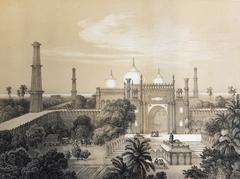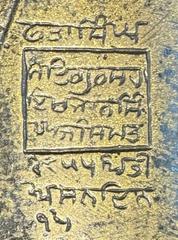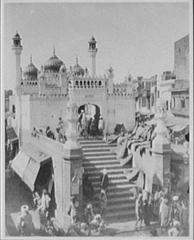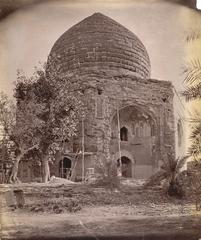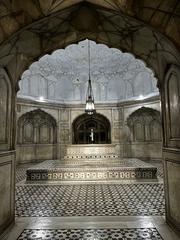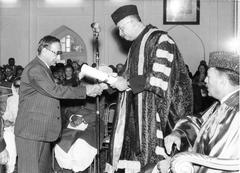Visiting the Tomb of Dai Anga in Lahore: Tickets, Hours, and History
Date: 01/08/2024
Introduction
The Tomb of Dai Anga, a stunning 17th-century Mughal mausoleum, stands as a significant historical and architectural marvel in Lahore, Pakistan. Located in the Mughal-era suburb of Begampura, outside the Walled City of Lahore, this mausoleum was constructed in honor of Zeb-un-Nisa, affectionately known as Dai Anga, the wet nurse of Mughal Emperor Shah Jahan. The tomb is also referred to as Gulabi Bagh (Pink Garden) and is situated along the historic Grand Trunk Road, providing a glimpse into the opulence and grandeur of Mughal architecture (Wikipedia). Dai Anga’s influential role in the Mughal court and her philanthropic activities, including the commissioning of the Dai Anga Mosque, highlight her legacy and significance in Mughal history (Travel Pakistani). This guide offers a comprehensive overview of the history, architectural brilliance, visitor information, and nearby attractions to ensure a memorable visit to this cultural gem.
Table of Contents
- [Introduction](#introductionintroduction)
- [History and Significance of the Tomb of Dai Anga](#history-and-significance-of-the-tomb-of-dai-angahistory-and-significance-of-the-tomb-of-dai-anga)
- [Historical Background](#historical-backgroundhistorical-background)
- [Dai Anga: A Life of Service and Influence](#dai-anga-a-life-of-service-and-influencedai-anga-a-life-of-service-and-influence)
- [Architectural Brilliance](#architectural-brilliancearchitectural-brilliance)
- [The Gulabi Bagh Gateway](#the-gulabi-bagh-gatewaythe-gulabi-bagh-gateway)
- [Interior Elegance](#interior-eleganceinterior-elegance)
- [Preservation and Conservation Efforts](#preservation-and-conservation-effortspreservation-and-conservation-efforts)
- [Cultural Significance](#cultural-significancecultural-significance)
- [Visitor Experience](#visitor-experiencevisitor-experience)
- [Impact of Modern Developments](#impact-of-modern-developmentsimpact-of-modern-developments)
- [Visitor Information](#visitor-informationvisitor-information)
- [Visiting Hours and Tickets](#visiting-hours-and-ticketsvisiting-hours-and-tickets)
- [Travel Tips](#travel-tipstravel-tips)
- [Nearby Attractions](#nearby-attractionsnearby-attractions)
- [Frequently Asked Questions](#frequently-asked-questionsfrequently-asked-questions)
- [Conclusion](#conclusionconclusion)
History and Significance of the Tomb of Dai Anga
Historical Background
The Tomb of Dai Anga, also known as the Gulabi Bagh (Pink Garden), is a 17th-century Mughal tomb complex located in the Mughal-era suburb of Begampura, outside the Walled City of Lahore, Pakistan. This mausoleum was built in honor of Dai Anga, the wet nurse of Mughal Emperor Shah Jahan, and wife of Murad Khan of Bikaner. The tomb is situated along the Grand Trunk Road, one of the former routes between Lahore and Delhi, and is close to other historical sites such as the 17th-century tomb of Hazrat Ishaan and the 18th-century Cypress Tomb (Wikipedia).
Dai Anga: A Life of Service and Influence
Born as Zeb-un-Nisa, Dai Anga was a significant figure in the Mughal court. Her family had close ties with the Mughal Empire; her husband, Murad Khan, served as a magistrate in the court of Emperor Jahangir, and her son, Muhammad Rashid Khan, was one of the best archers in the kingdom, dying in service to Shah Jahan’s eldest son, Dara Shikoh (Wikipedia). Dai Anga’s influence extended beyond her role as a wet nurse; she was a trusted confidante of Shah Jahan and was known for her philanthropic activities, including commissioning the Dai Anga Mosque in Lahore before departing for the Hajj pilgrimage (Travel Pakistani).
Architectural Brilliance
The tomb is a testament to Mughal architectural brilliance, showcasing intricate designs and fine craftsmanship. The mausoleum is rectangular in shape with eight rooms encircling the perimeter of a central chamber. The entire structure is built on a raised plinth, and a dome with frescoes is directly above the central chamber. The chamber itself is empty, as the actual tomb of Dai Anga lies below in a subterranean crypt, where she is buried next to her daughter, Sultana Begum (Wikipedia).
The exterior of the tomb is adorned with elaborate arches, ornate carvings, and delicate motifs, reflecting the opulence of Mughal aesthetics. The red sandstone facade complements the surrounding landscape, creating a captivating visual appeal. The use of red sandstone and marble adds to its grandeur, while the symmetrical layout, elegant domes, and minarets showcase the artistic genius of the era (Travel Pakistani).
The Gulabi Bagh Gateway
The mausoleum features a gateway that predates the tomb’s construction. Built in 1655 C.E. by the Persian nobleman Mirza Sultan Baig, the gateway was originally the entrance to a pleasure garden. The original garden was square in shape, measuring 250 Guz on each side (Wikipedia). The Gulabi Bagh Gateway, a protected heritage monument, received significant attention around 2016 due to concerns over potential damage from the Orange Line Project. Despite court proceedings and demarcation of boundaries, conservation plans for the gateway and the tomb have not been fully realized (Youlin Magazine).
Interior Elegance
Stepping inside the tomb reveals a world of beauty and serenity. The spacious halls are adorned with frescoes, intricate marble work, and calligraphy. The central chamber is richly decorated with carved inscriptions from the Quran and elegant frescoes made by the renowned calligrapher Muhammad Saleh. The tranquil ambiance invites visitors to reflect on the life and contributions of Dai Anga, creating a spiritual atmosphere (Wikipedia).
Preservation and Conservation Efforts
Preserving the Tomb of Dai Anga is of utmost importance to safeguard the cultural heritage of Lahore. The tomb complex is listed on the Protected Heritage Monuments of the Archaeology Department of Punjab (Wikipedia). However, the site has faced challenges over the years, including encroachments by neighboring structures, which have left only a narrow strip of garden between the tomb and the gateway. Conservation efforts have been hampered by inadequate attention from authorities and amateurish attempts at renovation, which have detracted from the historical and aesthetic value of the site (Youlin Magazine).
Cultural Significance
The Tomb of Dai Anga stands as a testament to grace, beauty, and historical significance. It serves as a link to the past, connecting us to the rich Mughal legacy. The monument is a reminder of our collective history and the need to protect and honor our heritage. By preserving and appreciating this cultural gem, we ensure that the legacy of Dai Anga and the Mughal era continues to inspire generations to come (Travel Pakistani).
Visitor Experience
The tomb is enveloped by well-maintained gardens, providing a serene retreat amidst bustling Lahore. Lush greenery, blossoming flowers, and well-manicured pathways create a tranquil environment, offering visitors a chance to unwind and appreciate the beauty of nature. The site is not only a historical landmark but also a peaceful escape for those seeking a moment of reflection and tranquility (Travel Pakistani).
Impact of Modern Developments
The construction of the Orange Line Metro Train in Lahore has had a significant impact on the Tomb of Dai Anga and other nearby heritage sites. The project raised concerns about potential damage to these historical monuments, leading to court proceedings and demarcation of boundaries to protect the sites. Despite these efforts, the need for expert conservation remains critical to preserve the historical and aesthetic value of the tomb and its surroundings (Youlin Magazine).
Visitor Information
Visiting Hours and Tickets
The Tomb of Dai Anga is open to visitors from 9:00 AM to 5:00 PM daily. Tickets are priced at PKR 50 for local visitors and PKR 200 for international tourists.
Travel Tips
- Best time to visit: Early morning or late afternoon to avoid the heat.
- Dress modestly as it is a historical and cultural site.
- Photography is allowed, but be respectful of the surroundings.
Nearby Attractions
- Hazrat Ishaan’s Tomb
- Cypress Tomb
- Shalimar Gardens (UNESCO World Heritage)
- Lahore Fort (UNESCO World Heritage)
- Badshahi Mosque (Badshahi Mosque)
- Wazir Khan Mosque (Wazir Khan Mosque)
- Lahore Museum (Lahore Museum)
Frequently Asked Questions
What are the opening hours of the Tomb of Dai Anga?
The site is open from 9:00 AM to 5:00 PM daily.
How much does it cost to visit the Tomb of Dai Anga?
Tickets cost PKR 50 for local visitors and PKR 200 for international tourists.
Are guided tours available?
Yes, guided tours can be arranged through local tour operators or at the site.
Conclusion
The Tomb of Dai Anga is a remarkable monument that encapsulates the rich history and cultural heritage of the Mughal era. Its architectural brilliance, serene surroundings, and historical significance make it a must-visit destination for history enthusiasts and those seeking a peaceful retreat. By preserving and appreciating this cultural gem, we ensure that the legacy of Dai Anga and the Mughal era continues to inspire generations to come. For further updates and travel guides, download our mobile app Audiala and follow us on social media.
References
- Wikipedia, 2024, https://en.wikipedia.org/wiki/Tomb_of_Dai_Anga
- Travel Pakistani, 2023, https://travelpakistani.com/blogs/tomb-of-dai-anga-lahore---a-testament-to-grace-and-legacy/442
- Youlin Magazine, 2016, https://www.youlinmagazine.com/article/visiting-dai-anga-monuments/MTc1OQ==

